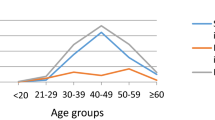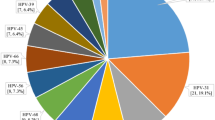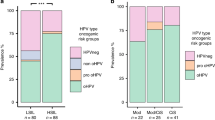Abstract
The prevalence of human papillomavirus (HPV) infection and other risk factors were studied in a high risk area for cervical cancer (Greenland) and in a low risk area (Denmark). From Nuuk (Greenland) and Nykøbing Falster (Denmark), random samples of 150 women aged 20-39 years were drawn. A total of 129 and 126 women were included in Greenland and Denmark, respectively. The proportion of HPV infected women assessed by ViraPap was similar in Denmark and Greenland (4.8 vs 3.9%). When type specific polymerase chain reaction (PCR) was used, the total HPV detection rate was 38.9% in the Danish population and 43.4% in the Greenlandic. A similar interrelationship between Greenland and Denmark applied to the HPV types 11, 16, 18 and 33. No relationship was observed between HPV detection and number of partners for any of the diagnostic methods. Significantly more Greenlandic than Danish women had antibodies to HSV 2, 76.0% and 26.2%, respectively. The prevalence of self-reported histories of selected venereal diseases was also highest among Greenlanders, except for genital warts where the prevalence was similar in the two areas. Greenlandic women had significantly more sexual partners, earlier age at first intercourse, more current smokers and less use of barrier contraceptives compared to the Danish women. This study confirms the results of our previous population-based cross-sectional comparison study in these areas, corroborating the conclusion that the prevalence of detectable HPV infection does not seem to be a determinant of cervical cancer incidence. However, by using DNA hybridisation techniques, temporal virus shedding is only measured at one point in time. Detectable virus shedding may not correlate with the risk of cervical cancer. In fact, HPV DNA detection may have different implications in different populations. In Denmark, HPV DNA detection may reflect transient, recently acquired infection, whereas in Greenland, it is more indicative of chronic persistent infection.
This is a preview of subscription content, access via your institution
Access options
Subscribe to this journal
Receive 24 print issues and online access
$259.00 per year
only $10.79 per issue
Buy this article
- Purchase on Springer Link
- Instant access to full article PDF
Prices may be subject to local taxes which are calculated during checkout
Similar content being viewed by others
Author information
Authors and Affiliations
Rights and permissions
About this article
Cite this article
Kjaer, S., de Villiers, EM., Çağlayan, H. et al. Human papillomavirus, Herpes simplex virus and other potential risk factors for cervical cancer in a high-risk area (Greenland) and a low-risk area (Denmark) – a second look. Br J Cancer 67, 830–837 (1993). https://doi.org/10.1038/bjc.1993.152
Issue Date:
DOI: https://doi.org/10.1038/bjc.1993.152



